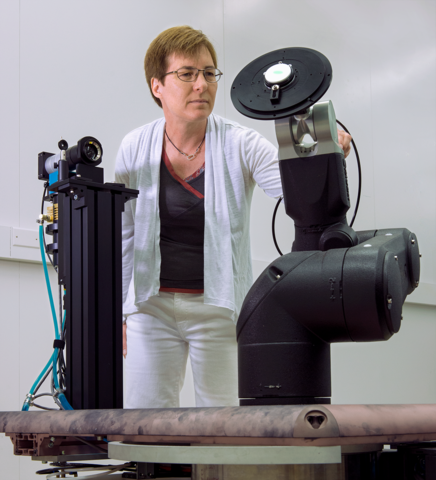
NIST physicist Heather Patrick with ROSI.
The National Institute of Standards and Technology (NIST) recently completed major upgrades to two key instruments serving critical national needs: measuring the properties of light as it is reflected from a surface or transmitted through a material. The two instruments together are at the core of NIST’s ability to set and maintain the official U.S. scales for those measurements.
Much as tuning forks provide a reference for piano notes, the scales allow operators of reflectance and transmittance instruments to calibrate their equipment by comparing their measurements against an authoritative source. That ensures that different devices produce comparable data.
It is nearly impossible to overstate the importance of uniform accuracy of such measurements in both everyday life and scores of essential science applications.
In the most familiar sense, the properties of the reflected or transmitted light profoundly influence our perception of, and hence preferences in, clothing, automobile finish, paint and coatings of all kinds, food, and much more. So exact color is of obvious and urgent interest to makers of consumer goods.
But accurate measurement of reflected and transmitted light, including wavelengths not visible to us, is also essential to a broad range of critical processes in manufacturing, pharmaceuticals, medical imaging, printed materials, optics and photonics, and satellite observation of weather, crop health, and ocean conditions, among very many others.
NIST maintains the national scales in the near ultraviolet (UV, wavelengths above about 250 nanometers(nm)), visible (400 to 700 nm), and the near- and short-wave infrared (IR, up to about 2400 nm) spectral regions. Dissemination of those scales – along with improvement in metrology traceable to the SI, support of U.S. defense labs, and coordination with national metrology institutes worldwide – are major goals of the program.
Reflectance
The properties of reflected light can change substantially depending on the angle of the incident light that strikes a sample and the angle at which it is detected after reflection, as well as the spectrum of the light source and the nature of the reflecting surface. For years, NIST has been a world leader in measuring those effects through the science of reflectometry, pursuing continuous improvements in the instruments and techniques needed to meet evolving industrial and scientific demands.
One important example is the newly upgraded, state-of-the-art Robotic Optical Scattering Instrument (ROSI) in NIST’s Physical Measurement Laboratory. Its capabilities are described in detail in the October 2021 issue of Applied Optics.
ROSI can measure reflection from both specular (mirror-like) and diffuse (rough surfaces that spread out reflected light) samples. It has an angular range of 0 to 80 degrees for both illumination and viewing. One exceptional feature of ROSI is its ability to measure at out-of-plane viewing angles; that is, viewing angles that are rotated from the incident plane. To visualize this, think of the sun rising in the east over a lake, and an observer viewing the water from the north shore. While other out-of-plane reflectance instruments exist at National Metrology Institutes over the world, NIST is unique in providing measurements over such a wide wavelength range.
“Along with commercial interests, ROSI’s customers are national and international government laboratories,” said PML scientist Heather Patrick.
For example, Earth-monitoring satellites use measurements of different wavelength bands of reflected light to determine ocean temperature, chlorophyll concentration, sea-surface height, speed and direction of currents, and many more quantities of interest to weather, climate, and the environment. To do so, the satellite instruments need a reference to calibrate their sensors. That can be done using a diffuser with exactly known reflectance properties and measurements of the sun’s angle when light strikes the diffuser.

“One of our longest-running customer relationships,” Patrick said, “is with NASA’s Diffuser Calibration Laboratory. Earth-observing satellites for applications like climate monitoring use a diffuse reflector called a solar diffuser to help calibrate the response of their cameras to different colors reflected by scenes in images of the Earth.
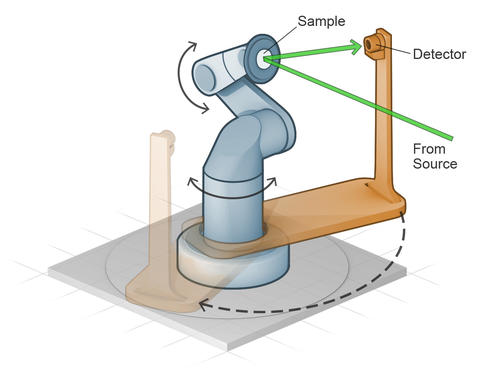
“NASA relies on ROSI calibrations to ensure the accuracy of the reflectance values assigned to the solar diffusers. It has been estimated that a conventional weather satellite can cost between $3 billion and $5 billion to develop and launch, so accurate measurements of all the satellite components are critical.”
In other uses on the planet’s surface, reflectometry can distinguish between oxygenated and de-oxygenated blood, differentiate between healthy and non-healthy plants, and identify the concentration and chemical composition of aerosols in the atmosphere.
“In the commercial realm,” Patrick said, “manufacturers of color measuring instruments rely on standards measured by ROSI to ensure accuracy and reproducibility of color measurements. A measurement on ROSI of a white sample, where the variation in reflectance from wavelength to wavelength is minimal, provides a known top-of-scale that instrument manufacturers can use to calibrate spectral response and enable reproducible color measurements.”
ROSI has been in continuous development and improvement since 2013, taking over many of the measurement tasks formerly accomplished by NIST’s aging STARR instrument – still in use for hemispherical reflectance measurements.
In recent years, a shorter-wavelength light source was added to ROSI. The original source could provide tunable light to a sample down to about 430 nm (visible deep violet). The new source extends the range to 250 nm in the UV. One reason is the need for reflectometry of UV sources used in germicidal applications.
“UV light can be used to sterilize air and surfaces, for example, in health care settings,” Patrick said. “UV reflectance measurements of the lamp components can help engineers design more efficient UV lamp housings, and UV reflectance measurements of paints and surfaces used in health care settings can help determine the UV dose required to inactivate pathogens in those settings.”
Big Gains in UV Transmittance Calibrations
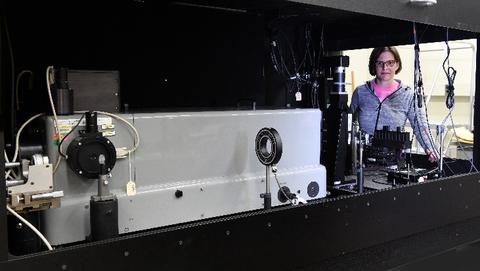
NIST researchers have recently souped up their ultraviolet (UV) light transmittance calibration service. Thanks to a lab upgrade, they have achieved a 70% reduction in uncertainty, as well as halving the measurement times.
“These upgrades have made it possible to make more customer measurements on our reference instrument,” said NIST’s Catherine Cooksey, referring to the main apparatus that NIST scientists built which makes measurements that are traceable to the SI, the international system of units used as the world standard. “Before, the time required for performing measurements on the reference instrument was very long, so we used a commercial instrument instead. But the reference instrument is now operating so well, and with such ease, that I can turn it on at any time and make a customer measurement directly.”
NIST transmittance calibrations, which assess the amount of light of different wavelengths passing through an object, are performed for customers who work with materials that filter light. These include glass manufacturers trying to optimize coatings for windows, or people building remote sensing instruments who rely on light filters, as well as pharmaceutical companies and military standards laboratories.
Indirectly, these measurements support myriad uses on a consumer level. For example, police officers might use a commercial transmittance sensor – traceable to NIST or another national metrology lab (NMI) – to test how much light is passing through a tinted car window, to determine if the window is in compliance with local laws.
Though the NIST service covers light transmittance measurements over a wide range of wavelengths – from the UV at 250 nanometers (nm) to shortwave infrared at 2500 nm – the recent measurement improvements most significantly impact the UV wavelength range between 250 nm and 450 nm.
The NIST setup lets researchers measure objects called neutral density filters, samples of tinted glass designed to absorb light of various wavelengths. Customers use these glass samples to assess the performance of their own transmittance devices.
So what did Cooksey and her colleagues change about their set-up to allow them to improve their UV measurements?
To calibrate a sample, NIST staff use a UV source that is “broadband,” meaning it produces many wavelengths of light. That light then goes through a monochromator, a series of gratings and mirrors that allows NIST staff to select a single frequency. The light then travels through the customer’s sample before hitting a detector that tells the scientists what passed through the glass.
For each wavelength, researchers also remove the glass sample and send the beam directly to the detector, giving them a way to assess the light’s intensity before and after transmittance. In this way, researchers can run the entire relevant spectrum of light through the glass sample one wavelength at a time.
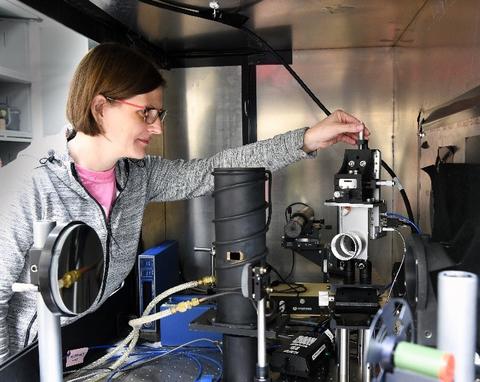
One issue with the old UV calibration system was that it used a deuterium lamp as its source. The deuterium lamp produced a fairly weak UV beam, which reduced the size of the signal the researchers could achieve. So Cooksey and colleagues replaced it with a more intense source, a laser-driven light source (LDLS), which uses a high-power laser to induce a gas-filled bulb to emit broadband light.
But the LDLS, though it gave the team more light to work with, was unstable: The amount of UV light fluctuated over the course of just a couple of minutes. Scientists solved this problem by adding a monitor line that could measure the light coming out of the monochromator in real time (see graphic).
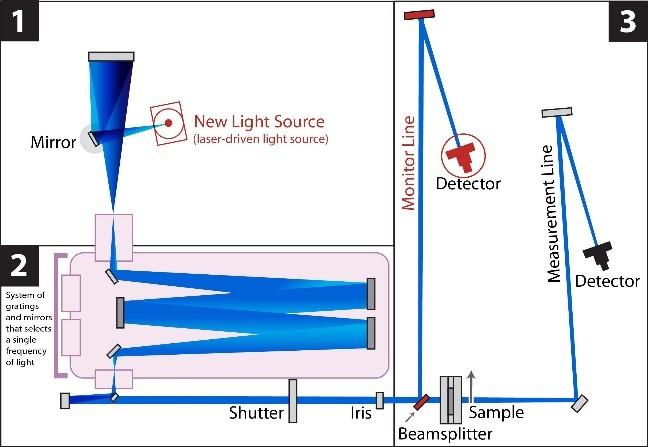
A change in measurement protocol also allowed the team to complete these calibrations twice as fast.
“Previously we used to make multiple scans to measure one spectrum,” Cooksey said. “But now we increase the number of readings that we’re taking within a single scan.”
Cooksey said that in the near future the new system will be used for customer measurements. Meanwhile, the researchers are preparing to formally compare the UV transmittance calibration set-up to a similar one at the National Research Council Canada (NRC-Canada). An international comparison lets labs validate their measurement methods and tie it to world measurements.
“This will allow us to provide evidence that says, ‘Yes, our uncertainties are a lot better than they once were,’” Cooksey said.
-- Reported and written by Curt Suplee and Jennifer Lauren Lee

